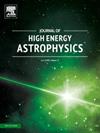Chasing super-horizon correlations: The promise of LiteBIRD polarization measurements
IF 10.5
4区 物理与天体物理
Q1 ASTRONOMY & ASTROPHYSICS
引用次数: 0
Abstract
It is well known that, since Cosmic Microwave Background (CMB) polarization originates at the surface of last scattering, scenarios in which perturbations are generated causally within the horizon cannot produce correlations at angular scales larger than about 2 degrees. In contrast, inflationary models predict a distinctive peak in the correlation functions at these large angular scales. By comparing the null hypothesis (no TE signal at large scales) with the ΛCDM prediction, we show that while Planck already provides strong statistical evidence for super-horizon perturbations, a future CMB satellite experiment as LiteBIRD will further reinforce this conclusion by improving current constraints by more than a factor of 3. We then consider an alternative explanation for the observed suppression of large-scale polarization: a low-k cutoff in the primordial power spectrum. We forecast the sensitivity of LiteBIRD to this cutoff scale, . In particular, we find that LiteBIRD will improve the constraint on by a factor of 1.4, outperforming Planck. These results highlight the critical role of large-scale polarization in establishing the presence of super-horizon correlations and offer new avenues to probe deviations from a scale-invariant primordial spectrum.
追逐超视界相关性:LiteBIRD偏振测量的前景
众所周知,由于宇宙微波背景(CMB)极化起源于最后一次散射的表面,在视界内产生因果扰动的情况下,不能在大于约2度的角尺度上产生相关性。相反,暴胀模型预测在这些大角度尺度的相关函数中有一个独特的峰值。通过将零假设(大尺度上没有TE信号)与ΛCDM预测进行比较,我们表明,虽然普朗克已经为超视界扰动提供了强有力的统计证据,但未来的CMB卫星实验(如LiteBIRD)将进一步加强这一结论,将当前的约束条件提高3倍以上。然后,我们考虑对观测到的大尺度极化抑制的另一种解释:原始功率谱中的低k截止。我们预测了LiteBIRD对这个截止尺度kc的灵敏度,特别是,我们发现LiteBIRD将kc的约束提高了1.4倍,优于普朗克。这些结果强调了大尺度极化在建立超视界相关性方面的关键作用,并为探测尺度不变原始光谱的偏差提供了新的途径。
本文章由计算机程序翻译,如有差异,请以英文原文为准。
求助全文
约1分钟内获得全文
求助全文
来源期刊

Journal of High Energy Astrophysics
Earth and Planetary Sciences-Space and Planetary Science
CiteScore
9.70
自引率
5.30%
发文量
38
审稿时长
65 days
期刊介绍:
The journal welcomes manuscripts on theoretical models, simulations, and observations of highly energetic astrophysical objects both in our Galaxy and beyond. Among those, black holes at all scales, neutron stars, pulsars and their nebula, binaries, novae and supernovae, their remnants, active galaxies, and clusters are just a few examples. The journal will consider research across the whole electromagnetic spectrum, as well as research using various messengers, such as gravitational waves or neutrinos. Effects of high-energy phenomena on cosmology and star-formation, results from dedicated surveys expanding the knowledge of extreme environments, and astrophysical implications of dark matter are also welcomed topics.
 求助内容:
求助内容: 应助结果提醒方式:
应助结果提醒方式:


